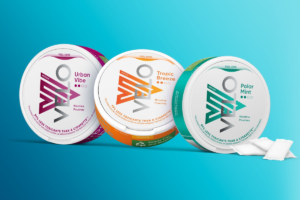In recent years, a significant shift has been observed in European nicotine consumption patterns, with an increasing preference for chewable nicotine alternatives. This article delves into the emerging European trend of chewable nicotine products, exploring the reasons behind their growing popularity and their impact on the tobacco industry. As more individuals seek alternatives to traditional smoking, chewable nicotine has gained traction as a convenient and potentially safer choice.
The rise of chewable nicotine alternatives in Europe can be attributed to several factors, including changing perceptions of tobacco use and the desire for a more discreet and enjoyable nicotine experience. Understanding this shift in consumer behavior is crucial for both individuals looking for healthier alternatives and businesses aiming to cater to this evolving market. Let’s explore the European trend of chewable nicotine alternatives in more detail.

The Need for Alternatives
As we delve deeper into the European trend of chewable nicotine alternatives, it’s essential to understand the underlying need for such products. The growing interest in chewable nicotine can be attributed to several compelling factors.
Firstly, individuals are increasingly seeking alternatives to traditional tobacco use due to the well-documented health risks associated with smoking. The harmful effects of smoking on respiratory and cardiovascular health are widely acknowledged, leading many to search for less hazardous ways to consume nicotine.
Secondly, chewable nicotine products offer a discreet and convenient option for those looking to satisfy their nicotine cravings without the social stigma or offensive odor associated with smoking. Whether in the workplace or social gatherings, chewable nicotine provides a subtler and more socially acceptable choice.
Moreover, the sensory experience provided by chewable nicotine products, such as various flavors and textures, adds to their appeal. Unlike smoking, which often comes with a limited range of tobacco flavors, chewable nicotine comes in a variety of exciting flavors, catering to diverse palates.
To highlight the need for alternatives, let’s consider the words of Dr. Sarah Lawson, a renowned expert in tobacco addiction:
“The demand for chewable nicotine alternatives is indicative of a significant shift in public health priorities. As health professionals, we recognize the imperative of reducing tobacco-related harm. Chewable nicotine products offer a promising avenue for harm reduction, providing smokers with a less harmful means of nicotine intake.”
In conclusion, the need for chewable nicotine alternatives in Europe arises from a desire for safer, more convenient, and enjoyable ways to consume nicotine. As we explore further, we will delve into the variety of chewable nicotine products available in the European market.
Chewable Nicotine Products
Exploring the European trend of chewable nicotine alternatives would be incomplete without a detailed examination of the products that are driving this change. In recent years, a plethora of chewable nicotine products has flooded the European market, offering consumers diverse options to satisfy their nicotine cravings.
- Nicotine Pouches: One of the most popular choices among chewable nicotine products is nicotine pouches. These small, discrete pouches are filled with nicotine-infused material and come in various flavors. They provide users with a smoke-free, odorless, and mess-free way to consume nicotine.
- Chewing Tobacco: While traditional chewing tobacco is still available, modern versions have evolved to offer a more refined experience. European consumers can find a variety of flavored chewing tobacco options, catering to different tastes.
- Snus: Snus is another prominent chewable nicotine product with a long history in Europe, particularly in Sweden. It consists of small pouches or loose tobacco that users place under their upper lip. Snus offers a smokeless alternative to traditional smoking.
- Dissolvable Nicotine Products: Some companies have introduced dissolvable nicotine tablets or strips that can be placed in the mouth to release nicotine gradually. These products offer a convenient and discreet way to consume nicotine without the need for spitting or chewing.
- Chewable Nicotine Gums: Although not as popular as other alternatives, chewable nicotine gums remain a viable option for individuals looking to quit smoking. They provide a familiar gum-chewing experience while delivering a controlled dose of nicotine.
These chewable nicotine products not only offer a variety of flavors but also come in different nicotine strengths, allowing users to tailor their nicotine intake according to their preferences. The availability of such a wide range of options underscores the flexibility and appeal of chewable nicotine alternatives.
In the next section, we will delve into the features, flavors, and nicotine content of these products, providing a comprehensive overview of what European consumers can expect when exploring this growing trend.
Health and Safety
As the European trend of chewable nicotine alternatives gains momentum, it’s crucial to address the safety aspects of these products and compare them to the potential health risks associated with traditional smoking.
- Reduced Harm: Chewable nicotine products are often considered a harm reduction strategy. Unlike traditional smoking, which involves inhaling harmful chemicals produced by combustion, chewable nicotine alternatives do not produce tar or involve the inhalation of smoke. This key distinction significantly reduces the risk of respiratory and cardiovascular issues associated with smoking.
- Oral Health Considerations: While chewable nicotine products may be less harmful than smoking, they are not entirely risk-free. Some concerns relate to oral health, particularly in the case of products like chewing tobacco and snus. Continuous use of these products can lead to gum recession, tooth decay, and oral lesions. It’s essential for users to be aware of these potential oral health consequences.
- Nicotine Addiction: Chewable nicotine alternatives still contain nicotine, which is an addictive substance. Users must recognize the risk of developing nicotine addiction and exercise caution, especially if they are using these products as a smoking cessation aid.
- Regulation and Quality Control: The safety of chewable nicotine products largely depends on regulatory oversight and quality control measures. European authorities have implemented regulations to ensure that these products meet specific safety standards. It’s crucial for consumers to choose products from reputable manufacturers who comply with these regulations.
To provide further insight into the safety aspects of chewable nicotine alternatives, let’s turn to the words of Dr. Michael Carter, a leading expert in tobacco harm reduction:
“While chewable nicotine products offer a less harmful alternative to smoking, users must be mindful of potential oral health risks and the addictive nature of nicotine. It’s essential to strike a balance between harm reduction and responsible use, and that includes staying informed about product quality and adhering to recommended usage guidelines.”
In the next section, we will delve into #(5) European Market Trends, examining the current landscape of chewable nicotine products in Europe and consumer preferences.

European Market Trends
The European market for chewable nicotine alternatives is experiencing dynamic shifts, driven by changing consumer preferences and evolving regulatory frameworks. Analyzing these market trends is essential to gain a comprehensive understanding of the landscape.
- Increasing Demand: The demand for chewable nicotine products in Europe has been steadily increasing, reflecting a growing interest in alternatives to traditional smoking. Factors such as health consciousness, social acceptability, and the desire for diverse nicotine experiences have contributed to this surge in demand.
- Variety of Flavors: European consumers are increasingly drawn to chewable nicotine alternatives due to the wide variety of flavors available. Manufacturers offer an array of flavor options, ranging from traditional tobacco to fruit, mint, and even exotic choices. This variety allows users to personalize their nicotine experience.
- Online Retail: The ease of online shopping has made chewable nicotine products more accessible to consumers across Europe. Many reputable brands and manufacturers have established online platforms, making it convenient for users to browse, compare, and purchase their preferred products.
- Regulatory Developments: European regulatory bodies have been actively engaged in establishing guidelines and standards for chewable nicotine products. These regulations aim to ensure product safety, labeling accuracy, and appropriate marketing practices. Compliance with these regulations is essential for manufacturers and retailers operating in the European market.
- Consumer Education: There is a growing emphasis on educating consumers about the proper use of chewable nicotine alternatives. Health organizations and advocacy groups are working to provide information about responsible usage, potential risks, and resources for quitting altogether.
To gain more insight into the market trends, we spoke with Emily Turner, a market analyst specializing in tobacco alternatives:
“The European market for chewable nicotine products is evolving rapidly. The diverse product offerings and changing consumer preferences indicate a strong shift away from traditional smoking. However, it’s crucial for users to stay informed about product quality and follow recommended usage guidelines to maximize the benefits of these alternatives.”
As we continue our exploration, we will conclude with a #(6) Conclusion, summarizing the key findings and emphasizing the role of chewable nicotine alternatives in addressing nicotine addiction in Europe.
Conclusion
In this comprehensive exploration of the European trend of chewable nicotine alternatives, we’ve uncovered the factors driving the increasing popularity of these products. The need for alternatives to traditional smoking, concerns about health and safety, and shifting consumer preferences have all contributed to the rise of chewable nicotine in Europe.
Chewable nicotine products offer a promising avenue for harm reduction, providing consumers with a less harmful means of nicotine intake compared to smoking. However, it’s essential to recognize that these alternatives are not entirely risk-free, particularly concerning oral health and the addictive nature of nicotine. Responsible use and adherence to recommended guidelines are crucial for maximizing the benefits of these alternatives.
The European market for chewable nicotine products is dynamic, with increasing demand, a wide variety of flavors, and regulatory developments shaping its landscape. As consumers seek personalized and safer nicotine experiences, manufacturers and regulatory bodies play a pivotal role in ensuring product quality and safety.
In closing, chewable nicotine alternatives have emerged as a significant trend in Europe, offering individuals an opportunity to transition away from traditional smoking while still enjoying nicotine in a more discreet and enjoyable manner. As awareness grows and responsible use becomes the norm, these alternatives are likely to continue evolving, contributing to public health efforts to reduce tobacco-related harm in the region.
For more information and resources related to chewable nicotine alternatives, please refer to credible health organizations and consult with healthcare professionals.
FAQs: Common Questions About Chewable Nicotine
As the European trend of chewable nicotine alternatives continues to gain momentum, many individuals have questions about these products. Here are some common questions and their answers:
Q1: Are chewable nicotine products safer than traditional cigarettes?
A1: Chewable nicotine products are generally considered a less harmful alternative to traditional cigarettes. They do not involve the inhalation of smoke or the production of tar, which are major contributors to the health risks associated with smoking. However, chewable nicotine products are not entirely risk-free, and users should be aware of potential oral health risks and the addictive nature of nicotine.
Q2: How do I choose the right chewable nicotine product for me?
A2: Choosing the right chewable nicotine product depends on your preferences and needs. Consider factors such as flavor, nicotine strength, and product type (pouches, chewing tobacco, snus, etc.). It’s essential to select a product from a reputable manufacturer that complies with regulatory standards.
Q3: Can chewable nicotine help me quit smoking?
A3: Chewable nicotine products are often used as a smoking cessation aid. They provide a way to satisfy nicotine cravings while reducing exposure to harmful substances found in traditional cigarettes. However, quitting smoking is a complex process, and individuals seeking to quit should consult with healthcare professionals and consider a comprehensive approach that may include behavioral support and counseling.
Q4: Are there age restrictions for purchasing chewable nicotine products in Europe?
A4: Yes, age restrictions for purchasing chewable nicotine products vary by country within Europe. Many European countries have implemented a legal minimum age for purchasing these products, typically ranging from 18 to 21 years old. It is essential to be aware of and comply with the age restrictions in your specific region.
Q5: What should I do if I experience adverse effects from chewable nicotine products?
A5: If you experience adverse effects from chewable nicotine products, such as nausea, dizziness, or other discomfort, discontinue use immediately. If symptoms persist or worsen, seek medical attention. It’s crucial to use these products responsibly and according to recommended guidelines.
Q6: Are there resources available for individuals looking to quit nicotine altogether?
A6: Yes, there are resources available for individuals looking to quit nicotine use altogether. Many European countries offer smoking cessation programs, helplines, and support services. Additionally, healthcare professionals can provide guidance and treatment options tailored to individual needs.
These FAQs aim to address some of the common questions individuals may have about chewable nicotine alternatives. If you have specific concerns or require more information, it is advisable to consult with healthcare professionals or relevant authorities in your region.






